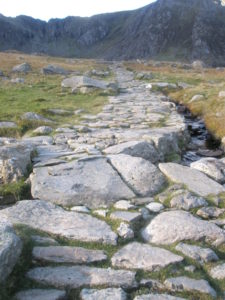PATH RESTORATION
In Cwm Idwal, stones are used to surface the paths.

As the geological attributes of Cwm Idwal are of international importance, stones from the site are not used. Suitable stones are bought and carried to the part of path that needs repair. This is usually done by helicopter, which costs around £900 per hour. Cwm Idwal National Nature Reserve has an annual budget for capital works, such as path restoration. This budget can change annually, therefore path work must be prioritised. In order to find out where the erosion is at its worst, the paths must be monitored regularly, and by making these surveys we can see which stretches of paths need restoration work.
When deciding which stretches of path are to be prioritised for restoration, the following must be considered:
- Annual footfall on the path / increased risk of erosion
- The threat of erosion to species
- The threat of erosion to habitats
- Potential risk of pollution
- Nature and location of path – a higher percentage of visitors use the lower paths in Cwm Idwal, therefore the footfall will be higher on those routes
- Public safety – if something has happened that makes any footpath dangerous, this piece of path will be addressed first.